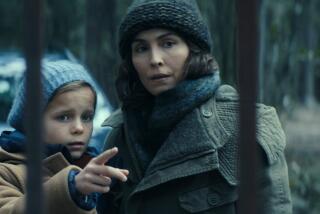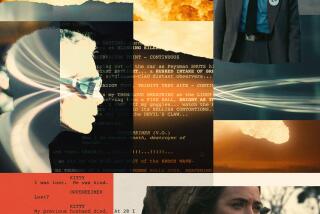Teacher Passes Her NASA Tests With Flying Colors
- Share via
Far from the cool shade of her New Hampshire home, Christa McAuliffe rode the sun-seared freeway south of Houston past bayous and oil derricks, turned onto NASA Road 1, thumped over a railroad crossing and came upon a former cattle pasture that for 22 years had been the breeding ground of astronauts. Full of hope, she arrived at the Lyndon B. Johnson Space Center.
It was Sunday, July 7, 1985, eight days after being chosen as one of 10 finalists in NASA’s competition for the first teacher in space.
Christa and her nine colleagues were on the threshold of the most intensive physical and psychological tests of their lives; pressure tests, strength tests, respiratory tests, claustrophobia tests, psychiatric tests, high-altitude tests, dental tests, blood tests, urine tests, more prodding, poking and probing than they had ever imagined. And then they were to face the clincher--the vomit comet.
Hours as a Lab Rat
Christa started her first day in the program at Building 8, where she donated seven vials of blood, answered 668 questions about her medical history and spent three hours as a lab rat, submitting to X-rays, an eye test, a dental checkup, the dreaded proctology exam, a pulmonary-function study and a series of procedures she had never heard of, including a musculoskeletal test in which technicians measured every inch of her body.
The doctors had forbidden her to eat for the previous 15 hours, so she had a Texas-size appetite by lunch. The technicians warned her not to try to catch up on lost calories, though, because next came the treadmill, NASA’s space-age running machine
Christa smiled quizzically as a dozen electrodes were attached to her torso, a blood-pressure gauge to her arm and breathing apparatus to her head. Dressed in a green hospital smock, white ankle socks and jogging shoes she stepped onto the inclined conveyor belt and then--it caught her by surprise--the machine started to roll.
Moving slowly at first, the treadmill gained speed until she had advanced from an easy stroll to a trot to a vigorous jog. Any second now, she thought, she would begin flailing like some cartoon character. She tried to grip the railings, but the technicians forbade it. Instead, Christa draped her arms over them and ran like Frankenstein until the machine slowed mercifully to a stop 13 minutes later. She had survived the first battery of tests.
‘Real Misgivings’
Next was the claustrophobia test.
“I have to tell you,” Christa said, “I have some real misgivings about going through with this one.”
The object of her anxiety--a personal rescue sphere--was called PRS, a thick, inflatable nylon ball that was 36 inches in diameter, linked to an oxygen supply and being developed for emergencies in space. Only two space suits fit on board the shuttle, and in case of an emergency, NASA expected the commander and the pilot to slip into the space suits, zip the rest of the crew into personal rescue spheres and carry them weightlessly to another shuttle or an orbiting space station.
Until then the PRS was a test lab, a tiny dark bubble in which the teachers were fitted with transmitters and electrodes and zipped in, one by one, to determined how they might react aboard the shuttle, where the total living space was no bigger than Christa’s kitchen. No one told them when they would be released.
As Christa curled her 5-foot-6-inch frame into the space-age beach ball, she tried to imagine herself crawling into a pup tent in the mountains of New Hampshire. She smiled meekly as a technician zipped her in.
“I thought I was going to start yelling and clawing to get out,” she said.
Then she lay back and folded her arms across her stomach. Christa was alone in the blackness. She imagined herself floating in space. It was the most peace she had had all week, and when the technician unzipped her 15 minutes later, she asked if she could take the ball home with her.
The next morning the teachers went back to school. For 5 1/2 hours they attended crash coarses on the perils of space flight--decompression sickness, hyperventilation, respiratory and circulatory problems, spatial disorientation, hypoxia and more. Christa, who had never completely conquered her childhood motion sickness, wanted so badly to impress NASA’s instructors that she volunteered for a ride on the spatial disorientation chair.
The purpose of the automated chair was to help astronauts prepare for the first dizzying moments of weightlessness in space. Christa climbed in, fastened her safety belt and closed her eyes. The chair started to spin, quickly gaining speed, and within seconds it spun so fast that she thought she would be hurled halfway across Texas.
The room spun faster than the carnival rides that had turned her stomach 25 years earlier. She suddenly felt ill. She wanted to get off. She wanted to go home. She wanted no part of the vomit comet.
Which, of course, was what all this was leading up to. And now it was time for the altitude chamber--a horrible green cylinder that turned Christa’s fingers blue and stole her sense of reason. An instructor had drilled the finalists for several hours about the chamber. An emergency aboard the space shuttle could lead to hypoxia, he told the group, an oxygen deficiency in the body tissues that was characterized by such symptoms as blurred vision, dizziness, a tingling sensation, uncoordination, hyperventilation and personality changes that included belligerence and euphoria.
“When you recognize the symptoms, you must get oxygen immediately,” the instructor said. “People die from hypoxia.”
Wearing oxygen masks, the 10 teachers and four instructors sat across from each other on steel benches, breathing pure oxygen for 25 minutes to cleanse their bodies of nitrogen that could create deadly bubbles in their blood.
Once the steel doors had been locked and the oxygen had been sucked out of the sealed chamber, the occupants climbed to a simulated height of 6,000 feet and plunged to 1,000 feet to be sure they could clear their ears.
At 28,000 feet, the oxygen was so thin that the symptoms of hypoxia appeared quickly. Soon Christa’s vision began to blur. As she subtracted 10 from 63, she noticed her fingers had started to turn blue. Then she noticed her answer: 59.
“I realized then that I probably needed some more oxygen,” she said.
No one in the history of U.S. manned space flight had left the launch pad without clearance from Dr. Terrence McGuire, NASA’s consulting psychiatrist. McGuire needed to be sure that everyone who boarded the shuttle could tolerate high-level stress.
He judged each of the teachers by a one-hour written exam and a two-hour personal interview. Most of the written questions were multiple choice, and Christa had a hard time settling on a single answer. Asked what kind of animal her friends saw her as--(a) fox, (b) beaver, (c) cat, (d) puppy, (e) owl or (f) lion--she answered (c) because she was independent like a cat and (b) because she was a busy as a beaver.
McGuire would not reveal details of the interview because of the confidentiality of the doctor-patient relationship, but he said each of the teachers had passed his test and that he had ranked them in order of their psychological suitability as a space flight participant. Christa had ranked the highest.
“In my opinion, she was the most broad-based, best-balanced person of the 10,” he said. “A lot of people just don’t see themselves as being OK these days. Someone like Christa has a more objective view of who she is and what she’s about. That means understanding and accepting her vulnerabilities as well as her strengths.”
The next morning Christa shoved a piece of Dentyne gum into her mouth and managed a smile as she hoisted herself up a steel ladder to the cabin of the KC-135. The flight would produce weightlessness by flying in a parabolic arc. Within minutes the jet soared six miles above the Gulf of Mexico. All but Christa unbuckled themselves from their seats in the rear of the jet and moved into a hollow cushioned area of the cabin that stretched 30 feet toward the cockpit.
Astronauts Judy Resnik and Dale Gardner emptied a bag of toys and the teachers frolicked in 40 seconds of free-form aerial gymnastics, bouncing off the walls, somersaulting through the cabin, skimming a Frisbee across the ceiling. Christa waited until she felt comfortable enough to climb out of her seat and clutch a railing. Her air-sickness bag stuck out of her pocket.
She tried touching her nose on the jet’s next plunge, but her arms were tugged down by the force of gravity. “It was like I had just failed a sobriety test,” she said.
On the next few dives she tossed a tennis ball, launched a paper plane, tossed a Frisbee and released a piece of string that rose as if it were hitched to a helium balloon. She bounced from wall to wall with the touch of a finger, winging through the cabin like a swan in slow motion.
Then she felt ill. The jet dived 27 times in two hours, and Michael Metcalf, the former Air Force pilot, had lost his breakfast early in the flight. Another candidate had fared no better, and now Christa felt queasy. She returned to her seat, her pride aching.
Christa composed herself on the descent and smiled for the cameras on the runway. Then the flight crew whisked the 10 teachers away to lunch.
She had made it, and that was all she needed to know. As the others ordered barbecued crawfish, a Cajun sausage dish and beans and rice, Christa rolled up her gum and decided on a beer and a plate of gumbo. “If you told me this morning I’d be eating anything for lunch,” she said, “I would have told you you were crazy. Now look at me. Maybe there’s hope yet.”
Excerpted from “I Touch the Future . . . The Story of Christa McAuliffe” by Robert T. Hohler. Copyright 1986, Robert T. Hohler. Reprinted by permission of the publisher, Random House. Distributed by Los Angeles Times Syndicate.
More to Read
Sign up for Essential California
The most important California stories and recommendations in your inbox every morning.
You may occasionally receive promotional content from the Los Angeles Times.













